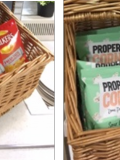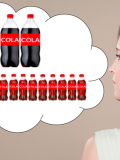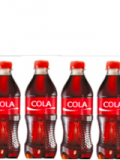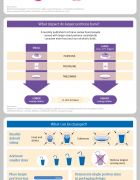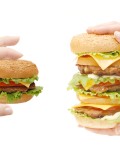Our research on diet
We study how our environments influence what we eat, and which interventions could change this so that our diets can be healthier.
Click on the images below to find out more about the work we have been doing in this area:
Key Studies:
In a novel study we compared the impact of increasing and decreasing the number of slots containing healthier and less-healthy options in vending machines in one English hospital. We were interested in the impact on snacks and cold drinks selected. Reducing the proportion of less healthy cold drinks from 25% to 5% of slots halved the energy purchased from drinks, suggesting this is a promising strategy for encouraging healthier drink selections. Findings were inconclusive when less-healthy snacks were reduced and healthier drinks or snacks were increased. Further research is needed to establish whether any effects might be smaller for snacks, and/or when the proportion of sales involving healthier options is lower initially. Read the findings of the study in full here Pechey, R, Jenkins, H, Cartwright, E, Marteau, TM (2019). Altering the availability of healthier vs. less healthy items in UK hospital vending machines: a multiple treatment reversal design. IJBNPA: 16(114) Two vegetarian options in the cafeteria of ‘College C’ – the Cambridge College that helped researchers run a “choice architecture” experiment. Credit: Nick Saffell. A study of over 94,000 cafeteria meal choices has found that doubling the vegetarian options – from one in four to two in four – reduced the proportion of meat-rich purchases by between 40-80% without affecting overall food sales. The results are from the first major study to look at whether tweaking food availability can “nudge” people towards better decision-making for both human health and preservation of the planet. Scientists from the University of Cambridge’s departments of Zoology, Geography and Public Health gathered over a year’s worth of mealtime sales data from three Cambridge college cafeterias. Two provided data on days with different menu set-ups, and a third college helped the researchers conduct a “choice architecture” experiment. The research team found the biggest increases in plant-based dining among the most carnivorous quartile of customers: those who had consistently picked meat or fish prior to the addition of a second veggie option. Moreover, the team detected no “rebound effect”. Opting for a vegetarian lunch did not make a compensatory meat-heavy dinner any more likely. The findings are published today in the Proceedings of the National Academy of Sciences. Diets full of meat are leading drivers of species loss and climate change, say scientists. Livestock and aquacultures behind meat, fish, dairy and eggs are responsible for some 58% of the greenhouse gas created by global food, and take up 83% of farmland despite contributing just 18% of the world’s calorie intake. “Shifting to a more plant-based diet is one of the most effective ways of reducing the environmental footprint of food,” said study lead author Emma Garnett, a conservationist from Cambridge’s Department of Zoology. “Replacing some meat or fish with more vegetarian options might seem obvious, but as far as we know no one had tested it before. Solutions that seem obvious don’t always work, but it would appear that this one does.” “Education is important but generally ineffective at changing diets. Meat taxes are unpopular. Altering the range of available options is more acceptable, and offers a powerful way to influence the health and sustainability of our diets.” – co-author Theresa Marteau, Professor of Behaviour and Health The researchers have contributed to food policy at the University of Cambridge, where the catering service has reduced meat options – including the removal of beef and lamb, the biggest contributors to meat-related greenhouse gas – and increased the range of vegetarian meals. Earlier this month, University cafeterias (separate from the colleges) announced a 33% reduction in carbon emissions per kilogram of food purchased, and a 28% reduction in land use per kilogram of food purchased, as a result of the changes. “Universities are increasingly at the forefront of providing plant-based options that are affordable and delicious, making it easier to choose a more sustainable diet,” said Garnett. “I think that’s what really has to change.” “We’re not saying all cafeterias and restaurants should turn vegan overnight. But if food were the film industry, vegetarian and vegan meals need to land more starring roles, and meat dishes have got to stop hogging the limelight.” – Emma Garnett, researcher at Cambridge’s Department of Zoology The new study had an observational and experimental component. For the observational, two colleges provided data on weekday term-time meal selections at both lunch and dinner during 2017. Meals were purchased using university cards topped up with credit, allowing researchers to analyse anonymised data that tracked what individual diners ate for each meal on every day. This dataset contained 86,932 hot meals (excluding salads and sandwiches) and 2,140 repeat diners. The range varied between occasional days with no vegetarian or vegan dishes, to days where 75% of the options were veggie. “One of the exciting things about this study is the scale of information on individual diners’ choices,” said co-author Andrew Balmford, Professor of Conservation Science at Cambridge. “It allowed us to test for rebound effects, when customers compensate for less meat at lunch by eating more in the evening. We found little evidence of this.” Researchers built statistical models to show that doubling the vegetarian offering, from a quarter to half of possible meals, increased the proportion of vegetarian sales by 62% in the first college, and 79% in the second college. (A real-terms increase of almost 15 percentage points in both colleges.) Caterers at a third college worked with researchers to conduct an experiment during the autumn term of 2017: lunchtime menus that alternated fortnightly between one veggie option (control) and two (experiment). Doubling availability increased the proportion of vegetarian sales by 41%, or almost 8 percentage points. Data from the summer term allowed researchers to assign 121 regular diners to a quartile based on their vegetarian meal consumption. “We discovered that changing the relative availability of vegetarian options had the strongest effect on those who usually eat more meat,” said Balmford*. Garnett argues that vegetarian options have been an “afterthought” on menus for too long. “Flexitarianism is on the rise. Our results show that caterers serving more plant-based options are not just responding to but also reshaping customer demand.” “Simple changes such as increasing the proportion of vegetarian options could be usefully scaled up, with the potential to help mitigate climate change and biodiversity loss,” she said. Reference E Garnett, A Balmford, C Sandbrook, M Pilling, T Marteau. Impact of increasing vegetarian availability on meal selection and sales in cafeterias. PNAS 30 Sept 2019. DOI: 10.1073/pnas.1907207116 Changing our food environments, by making certain foods less available or less convenient to access, may be one way of reducing how much we select, purchase or eat. Until now, the possible impact of such changes has not been known. We conducted a Cochrane Review to assess whether altering the availability (the range of options) or proximity (the distance at which they are positioned) of food products changes how much they are selected (such as purchased) or consumed. We searched for all available evidence from randomised controlled trials, and found 24 studies, including more than 3000 participants, all on food. We also searched for studies of alcohol and tobacco products but none were found. This review provides the most conclusive evidence to date that people select less of a type or range of food when there are fewer different options of that food available to choose from. For example, people select fewer unhealthy products from vending machines or in cafeterias when there are fewer unhealthy options available. The results are less clear on how this affects the amount of food that is actually consumed. This review also provides the most conclusive evidence to date that people consistently consume less of a food when it is placed further away than when it is nearer to them, although effects on selection are very unclear. The certainty of this evidence is low or very low but it suggests that consumption of unhealthy foods could be reduced by changing our food environments by i) reducing the the number of options available e.g. reducing the range of unhealthy foods in vending machines or on restaurant menus, or ii) moving less healthy products to less convenient locations e.g. away from supermarket checkouts. To read the findings of the study in full, click here. Hollands, G.J., Carter, P., Anwer, S., King, S.E., Jebb, S.A., Ogilvie, D., Shemilt, I., Higgins, J.P.T., Marteau, T.M. (2019). Altering the availability or proximity of food, alcohol and tobacco products to change their selection and consumption. Cochrane Database of Systematic Reviews; 8:CD012573. Impact of increasing the proportion of healthier foods available on energy purchased in worksite cafeterias: A stepped wedge randomized controlled pilot trial. Pechey, R., Cartwright, E., Pilling, M., Hollands, G. J., Vasiljevic, M., Jebb, S. A., & Marteau, T. M. Appetite. Post-intervention feedback amongst cafeteria patrons and worksite managers and caterers suggested high levels of acceptability. Several barriers to intervention implementation were identified. The predicted effect of labelling to reduce energy purchased was only evident at one out of six sites studied. Before progressing to a full trial, we propose that the calorie labelling intervention needs to be optimised, and a number of operational issues resolved. Impact of calorie labelling in worksite cafeterias: a stepped wedge randomised controlled pilot trial. Vasiljevic M, Cartwright E, Pilling M, Lee M-M, Bignardi G, Pechey R, Hollands GJ, Jebb SA, Marteau TM, 2018 Are sweet snacks more sensitive to price increases than sugar-sweetened beverages: analysis of British food purchase data. (2018). Smith RD, Cornelsen L, Quirmbach D, Jebb SA, Marteau TM. BMJ open. Participants perceived their consumption pace and amount to be greater with the smallest (250ml) compared to larger bottles. The smallest bottles were described as increasing the frequency of drinking occasions and encouraging consumption of numerous bottles in succession. Various factors associated with the smallest bottles were described as enabling consumption, like the perceived convenience and portability and the greater number of smaller vs. larger bottles available. Further work is needed to experimentally test the use of small bottles as a method for decreasing sugary drink consumption. Perceived impact of smaller compared with larger-sized bottles of sugar-sweetened beverages on consumption: a qualitative analysis. Mantzari, Hollands, Pechey, Jebb & Marteau, 2017 This is a protocol for a pilot stepped wedge randomised controlled trial to estimate the potential impact of three sets of physical micro-environment interventions to reduce energy purchased in workplace cafeterias: 1) size of portions, packages and tableware; 2) availability of healthier vs. less healthy options; and 3) energy labelling. The results of this pilot study will inform the design and procedures for a larger trial. Physical micro-environment interventions for healthier eating in the workplace: protocol for a stepped wedge randomised controlled pilot trial. Vasiljevic, Cartwright, Pechey, Hollands, Couturier, Jebb & Marteau, 2017. We assessed the feasibility of running a trial on the impact of bottle size on in-home consumption of cola, in which households received a set amount of cola each week for four weeks, in bottles of one of four sizes (1500 ml, 1000 ml, 500 ml, or 250 ml). 16 households were tested and we found the procedures to be both feasible and acceptable. Issues associated with the study design were identified, which may impact the validity of the primary outcome (consumption). These include consumption driven by study-determined supply and a failure to capture out-of-home consumption. Methods to avoid these would be needed before conducting a definitive trial. Impact of bottle size on in-home consumption of sugar-sweetened beverages: a feasibility and acceptability study. Mantzari, Hollands, Pechey, Jebb & Marteau, 2017. Presenting images of negative health outcomes led to more healthy food choices, irrespective of whether they were paired with images of energy-dense snack foods or of fruit. Images of positive health outcomes did not alter food choices. This work provides insights relevant to health communication interventions where aversive visual images are used to alter the consumption of products that impact on human health. Pairing images of unhealthy and healthy foods with images of negative and positive health consequences: impact on attitudes and food choice. Hollands & Marteau. 2016 Does reducing unhealthier options or increasing healthier options increase healthier selections from vending machines?
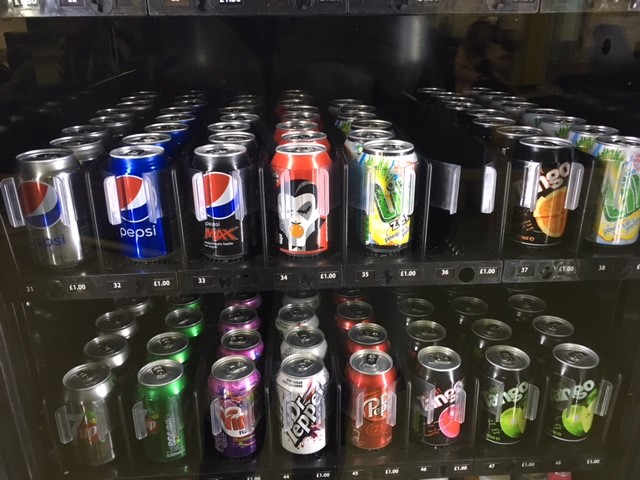
Veg ‘nudge’: extra vegetarian option reduces meat consumption without denting food sales
Does altering the availability or proximity of food, alcohol and tobacco products change their selection and consumption?

Does increasing the proportion of healthier options in cafeterias lead to healthier purchasing?
 Increasing the proportion of healthier foods available could encourage healthier consumption, but evidence to date is limited in scope and quality. In this study, six English worksite cafeterias increased the proportion of healthier cooked meals, snacks, cold drinks and/or sandwiches available, while aiming to keep the total number of food options constant. Healthier options were defined as those with fewer calories (kcal). When sites offered these changed food options, we found a 7% reduction in calories (kcal) purchased from targeted food categories across all the worksites. However, impact varied across sites, with calories purchased from targeted categories significantly reduced in two sites, but no significant differences observed in the other four sites. No difference was observed in the revenue taken by the worksites when healthier options increased. Overall, increasing the proportion of lower calorie options available in worksite cafeterias seems a promising intervention for healthier consumption. The reasons why this effect was found in some but not all the worksite cafeterias needs further study.
Increasing the proportion of healthier foods available could encourage healthier consumption, but evidence to date is limited in scope and quality. In this study, six English worksite cafeterias increased the proportion of healthier cooked meals, snacks, cold drinks and/or sandwiches available, while aiming to keep the total number of food options constant. Healthier options were defined as those with fewer calories (kcal). When sites offered these changed food options, we found a 7% reduction in calories (kcal) purchased from targeted food categories across all the worksites. However, impact varied across sites, with calories purchased from targeted categories significantly reduced in two sites, but no significant differences observed in the other four sites. No difference was observed in the revenue taken by the worksites when healthier options increased. Overall, increasing the proportion of lower calorie options available in worksite cafeterias seems a promising intervention for healthier consumption. The reasons why this effect was found in some but not all the worksite cafeterias needs further study.What is the potential impact of calorie labelling in worksite cafeterias? A pilot study
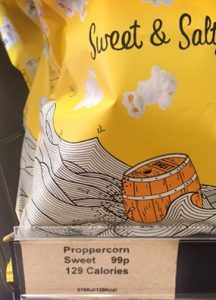 Reducing excess consumption of food and drink is core to tackling the high prevalence of overweight and obesity in the UK and elsewhere. Here we provide the results of a pilot trial estimating the potential impact of calorie labelling on energy purchased across six worksite cafeterias.
Reducing excess consumption of food and drink is core to tackling the high prevalence of overweight and obesity in the UK and elsewhere. Here we provide the results of a pilot trial estimating the potential impact of calorie labelling on energy purchased across six worksite cafeterias.Taxing sweet snacks may bring even greater health benefits than taxing sugar-sweetened drinks
 The UK Government levy on sugary drinks producers started in April 2018. This will potentially influence the cost of a large range of non-alcoholic beverages. Our new study (published 26th April 2018) looks at how increasing the price of snack foods might compare in impact. We found that a 10% increase in the price of sweet snacks could lead to a similar reduction in consumer demand as the same price increase for sugar-sweetened drinks. However, such a price increase is estimated to have knock-on effects that may further reduce purchases of sugar-sweetened drinks and other snacks. Furthermore, as sweet snacks provide twice as much sugar in the diet as sugar-sweetened drinks, the overall reduction on sugar intake could be even greater than that observed with price increases for sugar-sweetened drinks.
The UK Government levy on sugary drinks producers started in April 2018. This will potentially influence the cost of a large range of non-alcoholic beverages. Our new study (published 26th April 2018) looks at how increasing the price of snack foods might compare in impact. We found that a 10% increase in the price of sweet snacks could lead to a similar reduction in consumer demand as the same price increase for sugar-sweetened drinks. However, such a price increase is estimated to have knock-on effects that may further reduce purchases of sugar-sweetened drinks and other snacks. Furthermore, as sweet snacks provide twice as much sugar in the diet as sugar-sweetened drinks, the overall reduction on sugar intake could be even greater than that observed with price increases for sugar-sweetened drinks.How do consumers perceive smaller vs. larger bottles of sugary drinks?
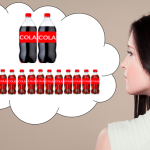 Sixteen consumers of sugary drinks were interviewed about their experiences of using four different bottle sizes of cola: 1500 ml, 1000 ml, 500 ml, and 250 ml.
Sixteen consumers of sugary drinks were interviewed about their experiences of using four different bottle sizes of cola: 1500 ml, 1000 ml, 500 ml, and 250 ml.Can interventions in workplace cafeterias modify employees’ diets?
 Reducing excessive consumption of food and soft drinks is core to tackling the high rates of overweight and obesity in the UK and elsewhere. It is estimated that about one third of our daily energy intake is consumed while at work, with most of the food consumed not brought from home.
Reducing excessive consumption of food and soft drinks is core to tackling the high rates of overweight and obesity in the UK and elsewhere. It is estimated that about one third of our daily energy intake is consumed while at work, with most of the food consumed not brought from home.Does bottle size affect the amount of cola consumed at home?
Does presenting images of negative health outcomes lead to healthier food choices?
 We examined the impact on people’s choices of presenting food images paired with positive or negative images of the health consequences of eating those foods.
We examined the impact on people’s choices of presenting food images paired with positive or negative images of the health consequences of eating those foods.
Publications related to diet:
2019
2018
2017
2016
2015
2014
2013

